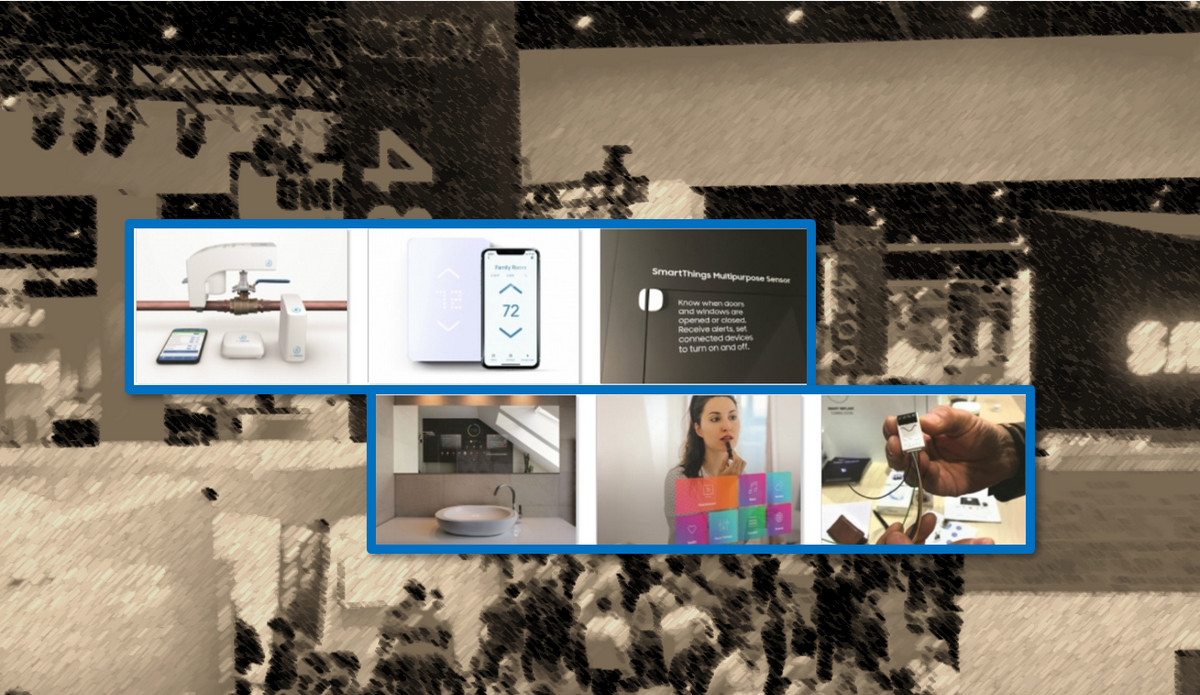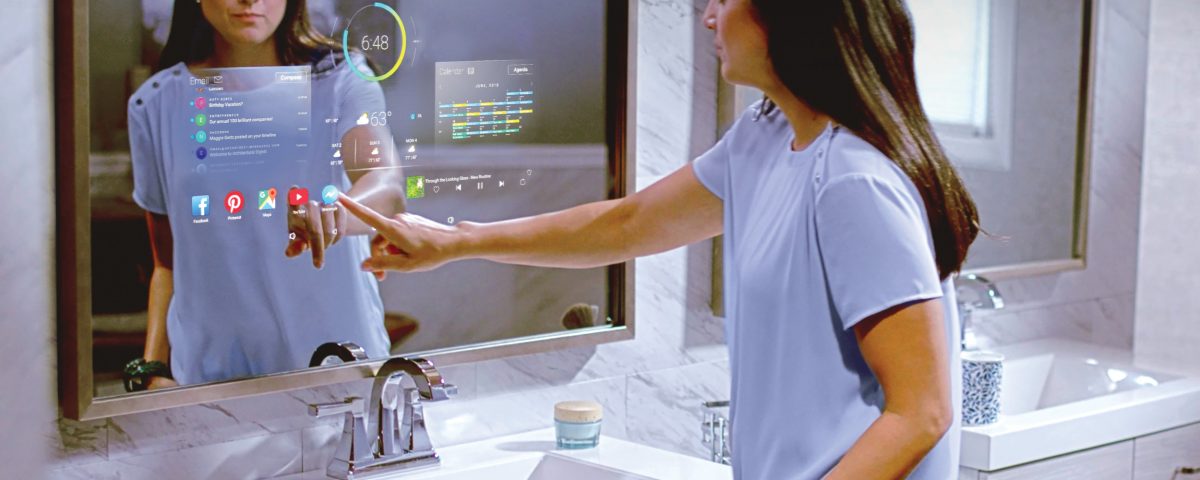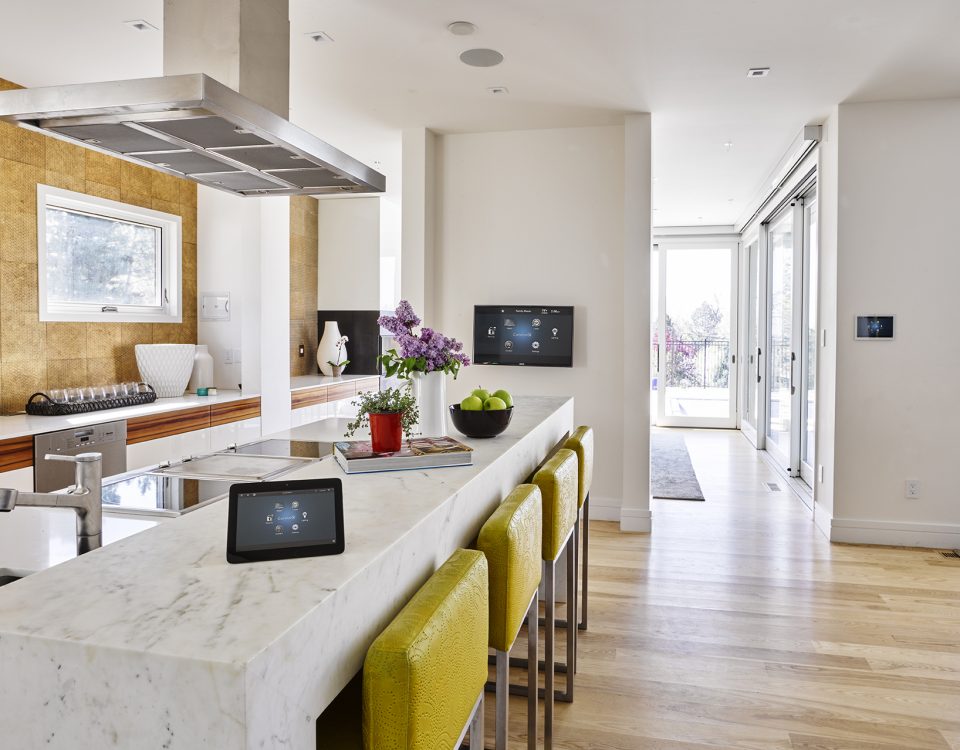Oltre ai televisori 8K

Ridare al settore il primato di innovazione
Gennaio 3, 2019
Come risparmiare energia con una casa intelligente
Gennaio 8, 2019Oltre ai televisori 8K, MicroLED e ai fantastici sistemi audio, CEDIA Expo 2018 ha presentato altre tendenze per la casa intelligente tra cui ombrelli da giardino robotizzati, sensori IoT multiuso e sistemi intelligenti di rilevamento delle perdite.

CEDIA Expo 2018 potrebbe essere finita da tempo, ma il grande show di smart-home ci fornirà grandi storie di home-tech per molti mesi (o anni) a venire.
CE Pro e tutti gli altri punti vendita (e la maggior parte dei partecipanti ai rivenditori) hanno coperto gran parte delle notizie di grande successo e di pane all’occhiello del 2018: display 8K, pannelli MicroLED, altoparlanti straordinari, tutto motorizzato, altoparlanti intelligenti e assistenti vocali, e … e Google e Nest.
Ma chi ha vagato per il resto dello show ha probabilmente trovato nuove opportunità in boot piccoli come 5mq. I prodotti non hanno necessariamente abbagliato, ma ti hanno fatto diventare Hmmmmm. Ombrelloni a motore, regolatori di valvole per acqua, sensori multifunzione e specchi intelligenti erano solo alcune delle categorie di prodotti sulla strada verso la massa critica nella comunità CE Pro.
Fornendo una svolta alla tecnologia domestica, queste categorie potrebbero aiutare gli integratori ad espandersi in nuovi mercati e generare nuovi flussi di entrate. Dopo aver avuto un po ‘di tempo per lasciare che questi prodotti marini nelle nostre teste negli ultimi mesi, abbiamo trovato un elenco di alcuni prodotti di nicchia che hanno catturato la nostra attenzione …
Smart Mirrors
Nell’ultimo sondaggio degli home remodelers della National Association of Home Builders, i bagni hanno conquistato il primo posto, seguito dalle cucine, come lo spazio più popolare da ristrutturare (81% contro 78%).
Questo presenta un’enorme opportunità di vendere la tecnologia come parte del rifacimento totale.
Gli specchi intelligenti sono ideali per ristrutturazioni di bagni e aziende come Electric Mirror, Clearview Displays, Agath, Aquavision e Séura stanno introducendo nuove fantastiche funzionalità nei loro specchietti da toilette, costruendo sul loro portafoglio di specchi TV.
Entrambe le società offrono mirror, di dimensioni e stili personalizzati, in cui è possibile scaricare una varietà di app.
Quelli possono essere app da sistemi di controllo di terze parti, singoli prodotti per la casa intelligente, servizi di streaming musicale, previsioni meteorologiche, ecc. Entrambi offrono anche specchi con Bluetooth integrato, quindi la musica può essere riprodotta e riprodotta da altoparlanti integrati nello specchio. L’integrazione di controllo e musica sono enormi funzioni di vendita, in quanto riduce la necessità di tastiere, telecomandi e altoparlanti indipendenti, elementi che occupano spazio e talvolta possono disturbare i progettisti e i rimodellatori.
Séura, nel frattempo, ha aggiunto le funzionalità di Amazon Alexa a una nuova linea di mirror. La tecnologia abilitata alla funzionalità vocale è integrata nello SMART Mirror dell’azienda e in Bluetooth; un utente parla e lo specchio risponde. Lo specchio Alexa / Bluetooth di Séura ha ricevuto una reazione positiva, in quanto gli integratori hanno chiaramente apprezzato il fattore wow, così come un contingente di designer di interni che è riuscito a interagire con lo specchio senza impronte digitali su uno degli stop di Design Connection Tour.
Il prodotto è un ottimo modo per portare in modo elegante e intuitivo la tecnologia e la voce in bagno, soprattutto perché è una delle stanze più utilizzate all’interno della casa, appena dietro la cucina!
“Alexa, ascolta la mia playlist Wake Up.” “Quali sono le previsioni del tempo per oggi?” “Alexa, abbassa la temperatura di 65 gradi.”
Purpose-Built & Multipurpose Sensors
I sensori sono le sentinelle della casa intelligente. Osservano i cambiamenti nell’ambiente domestico, trasmettono avvisi e scene di automazione coinvolgenti. Nel corso degli anni, i sensori sono diventati più intelligenti, più versatili e più proattivi. 2GIG e la casa madre Nortek Security & Control lo hanno dimostrato quest’anno sviluppando sensori per applicazioni molto specifiche. Samsung ha adottato un approccio diverso sviluppando per la sua linea SmartThings un sensore che può essere utilizzato per una moltitudine di scopi diversi. Progettato espressamente per le famiglie proprietarie di armi da fuoco, il rilevatore di movimento pistola da 2GIG si attacca al grilletto di una pistola, un fucile o un fucile a pompa e invia un avviso a un’app per smartphone se la pistola viene spostata. Funzionando in modo simile ma per circostanze diverse è il 2GIG Stove & Grill Guard. Si attacca alla maggior parte delle manopole della stufa e della griglia per avvertire i proprietari di abitazione se il forno è stato lasciato acceso. Come molti dei sensori 2GIG, è possibile utilizzare un’app remota per impostare regole specifiche; ad esempio, invia una notifica solo se la stufa è stata lasciata accesa per più di 30 minuti. Sia il Gun Motion Detector che il Stove and Grill Guard possono inviare notifiche a un touchpanel 2GIG GC2 o GC3, nonché a sistemi Honeywell. Nel frattempo, un paio di elementi della checklist per i sensori potrebbero essere monitorare le fluttuazioni di temperatura e sapere quando una porta o una finestra sono state aperte. Ciò che rende unico il sensore multiuso Samsung SmartThings è che può monitorare sia le condizioni che le vibrazioni. Perché le vibrazioni? Come ha spiegato il portavoce della mostra SmartThings, è un ottimo modo per sapere quando una lavatrice o un’asciugatrice sono instabili. Per quanto riguarda la sua applicazione a porte e finestre, SmartThings suggerisce di pensare oltre l’esterno di una casa.
Il sensore multiuso è utile per porte su armadi per liquori, cucine e armadi per il bagno per proteggere i bambini dai prodotti per la pulizia e cassetti che sono vietati…
Extremely Portable Door Cams
Think of your clients. Now think of your clients’ kids. They might be living in dorm rooms, apartments or sharing rent with friends. Drilling, cutting, and mounting products permanently in these types of dwellings is often prohibited, leaving few options for home security. This is precisely why Remo+ developed its RemoCam.
This wireless doorcam hangs over the door much like an over-the-door hook rack. Its adjustable bracket can fit the width of most doors, and can be secured in place with a few screws. Despite the easy installation process, the RemoCam boasts impressive monitoring capabilities.
Related: DIY Doorcams from Remo+ and Panasonic Present Opportunity for Pros
Thanks to its over-the-door design, the Wi-Fi chipset and antenna are housed in the back of the device, which is situated inside the home, rather than outside. This results in optimal connectivity and video transmission. It has a 160-degree field of view, sends push notifications to a user’s smartphone, and delivers 720p HD video.
A built-in microphone supports two-way video, and video footage can be recorded to view later.
Smart Enablers for Dumb Products
Many home-automation vendors make little smart-enabling relays that turn dumb analog products into smart devices. A simple relay wired to the legacy device can “push the buttons” remotely via Z-Wave, ZigBee, Bluetooth, and other standard smart-home standards, as well as proprietary protocols like Crestron’s Infinet.
Recently, home-automation developer Fibaro, part of the Nice Group of companies, announced “Implant,” a tiny adapter that Z-Wave-enables relay-controllable electronics.
All that old gear your clients own can be added to the control platform. Think record players, VCRs, CD players, and other outdated gear that some customers simply can’t part with. Stay tuned for U.S. availability.
Smart Water Valve Controllers
Based on the number of smart water valve controllers showcased at CEDIA Expo 2018, intelligent plumbing could be the next big thing for the smart home. The good news is, you don’t need a plumbing license to install them.
These solutions have been widely available at consumer outlets like Amazon and Home Depot, but as is the case with other types of DIY products, many consumers would still rather have a pro handle the installation and setup. It’s the reason these manufacturers are now developing special programs for not only plumbers but also home systems professionals.
They are also proving their commitment to the pro channel by though integration with popular third-party products and control systems and, of course, simply exhibiting at tradeshows like the CEDIA Expo.
So why should you care about smart plumbing products? Sure, you’ll probably need to install a lot of them to make it worthwhile, but they’re an easy sell.
More than 14,000 water damage claims are filed with insurance providers each day the U.S., with the cost of restoration averaging $12,000. Even the tiniest of leaks in a water line can do serious damage. A 1/8- inch crack in a pipe can spill 250 gallons of water in a day.
Most of the water valve controllers displayed at the CEDIA Expo can be installed in less than 15 minutes, providing a great opportunity to get in and out of a job quickly, and providing your customers with unbeatable peace of mind.
Related: LeakSmart Brings New Market Opportunity with Smart Leak Detection to CEDIA Expo 2018
The way by which the Flo water valve controller detects leaks is unique and innovative. It continually monitors the water pressure; when that pressure changes, it could be a sign of trouble, like a small leak — even one as small as a drop of water per minute. Your customers would likely never know a leak like this existed until months later when they actually see the damage.
Another perk: Flo Technologies offers customers a reimbursement program called HomeProtect. For $5 a month, program will reimburse homeowners for their insurance deductibles, up to $2,500 if their Floequipped home suffers major water damage.
Customers can receive notification through the Flo app, view water consumption habits and adjust the valve’s level of vigilance, like having the valve automatically shut off the water line while homeowners are on vacation.
In other modes, it might send a notification but wait for a user to command the valve shut. Where LeakSmart really stands apart is in its degree of integration. It works with Nest, Control4, and soon Google Assistant and Amazon Alexa. Should a Nest thermostat detect a drop in temperature, for example, it can signal the LeakSmart to turn off the water line to prevent freezing pipes from bursting.
The valve controller can be controlled and automated as part of a Control4 ecosystem, as well. Upcoming Amazon Alexa and Google Home integration will enable control via voice commands.
The Guardian from Elexa is not just a smart water valve. It’s an entire suite of water mitigation products that work together via a Z-Wave bridge to protect a home. Also available are a leak sensor, door/window sensor, motion detector, and a smart electrical plug. Plus there’s a battery backup device that keeps the valve controller working in a power outage.
Robotic Patio Umbrellas
The creation of outdoor living spaces is one of the biggest trends in homeownership for 2018. People are spending big bucks to transform their backyards into legitimate living spaces, complete with fully functional kitchens, high-quality audio systems, weather-resistant displays and automated landscape lighting.
Offering integrators another element to deliver to clients’ outdoor entertainment areas is a newcomer to the custom electronics space from ShadeCraft, and an Expo veteran, Screen Innovations. Dubbed the “Sunflower,” ShadeCraft’s robotic “parasol” is packed with so much tech it actually mitigates the need for to install some common outdoor amenities.
Integrated into this one umbrella, which measures 7 by 7 feet and stands about 10 feet tall, are Harman Kardon wireless voice-enabled speakers, colored LED lighting, a Wi-Fi and Bluetooth hub, USB charging station, HD surveillance camera, and a wind sensor that automatically signals a built-in motorized mechanism to close the umbrella when the conditions warrant it.
The internal motor that moves the umbrella — and the rest of the gear — is powered by an array of small solar panels attached to ribs of the umbrella. These panels also enable the umbrella to track the sun and position itself for maximum solar harvesting and shading.
Slideshow: Click here to see each product up close!
One more sunny selling feature: each part of the Sunflower can be controlled via Harman Kardon’s Sonique far-field voice recognition technology. There is also a companion app for control via mobile device. ShadeCraft expects Sunflower to start shipping for around $10,000 in April and hopes to integrate it with various smart home platforms.
As part of its recent expansion into the shading business, Screen Innovations demonstrated at CEDIA Expo a smart retractable patio sailcloth. Aptly called “Sail,” it has been engineered to be integration friendly like Screen Innovations’ other shading options.
The 16-foot-long by 14-foot-wide Dacron material extends and retracts from a center “mast” via third-party control platforms, as well as from its own keypad, waterproof remote or Amazon Alexa voice commands.
Retailing for $13,900 without an optional weighted stand and $15,400 with the stand, Hue lighting can be added as an accessory. Red and pink lighting from the Hue can help keep bugs away. An anemometer tells the screen to retract when it’s too windy.
Electric Baseboard Heating Controller
As long as there are old homes, there will be baseboard heaters. A spokesperson at the Mysa booth estimates that about 20 percent of homes use such heaters. Unlike other modes of heating, though, they’ve been slow to catch on to the smart home trend.
Mysa brings baseboard heating into the modern ages with a smart Wi-Fi thermostat made expressly for this mode of heating. The smart thermostat connects to 240V or 120V wiring, and offers a host of programming options: scheduling, vacation mode, and zone control.
These setting can be executed through a companion mobile app, which provides remote access and control. Mysa expects geolocation and energy reports to join the list of features soon.
Here’s the really good part: the thermostat integrates with Apple HomeKit, Google Assistant, Amazon Alexa and IFTTT. No word on integration with third-party control platforms, though.
Decor-Friendly In-Wall Enclosures
There’s been a truce in the battle between design and technology. Fostering the fusion of looks and performance are in-wall enclosures promoted at the CEDIA Expo by Vanco, TDG, Origin Acoustics, SeeLess Solutions, Thenos and others.
The Spot for Dot by Vanco, VAIL from The DaVinci Group, and the Dot Wall Mount from Origin Acoustics recess an Amazon Echo Dot into the wall and amplify it for music distribution purposes. The in-wall mounts offer the flexibility of being able to position an Amazon Echo Dot for optimal pick-up and responsiveness of the Dot’s microphone.
Focusing on merging Sonos Play:1 speakers into the home design is Thenos. After two years of development, its Play-Box in-wall enclosure available to home systems integrators.
The PlayBox allows a Sonos Play:1 to sink into the wall, freeing up space and offering the freedom to place the speakers where they sound best.
Lastly, SeeLess, a newcomer to the CEDIA Expo, exhibited a line of plaster in-ceiling and in-wall mounting solutions for a variety of devices: light switches, outlets, keypads, dimmers, thermostats, Wi-Fi access points, smoke detectors.
SeeLess says because the mounts allow the devices to sink into the wall surface, they no longer conflict with the room cosmetics.





1 Comment
Hi, this is a comment.
To delete a comment, just log in and view the post's comments. There you will have the option to edit or delete them.